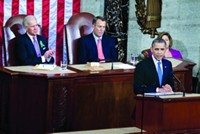Advertisement
Grab your lab coat. Let's get started
Welcome!
Welcome!
Create an account below to get 6 C&EN articles per month, receive newsletters and more - all free.
It seems this is your first time logging in online. Please enter the following information to continue.
As an ACS member you automatically get access to this site. All we need is few more details to create your reading experience.
Not you? Sign in with a different account.
Not you? Sign in with a different account.
ERROR 1
ERROR 1
ERROR 2
ERROR 2
ERROR 2
ERROR 2
ERROR 2
Password and Confirm password must match.
If you have an ACS member number, please enter it here so we can link this account to your membership. (optional)
ERROR 2
ACS values your privacy. By submitting your information, you are gaining access to C&EN and subscribing to our weekly newsletter. We use the information you provide to make your reading experience better, and we will never sell your data to third party members.
Policy
Chemistry awaits US presidential pick
A switch to Biden would change pandemic, environment, and immigration policies; Congress has a bigger role in other areas
by Megha Satyanarayana , Melody M. Bomgardner , Britt E. Erickson , Rick Mullin , Alexander H. Tullo , Andrea L Widener
November 6, 2020
| A version of this story appeared in
Volume 98, Issue 43

The 2020 US presidential election has been one of the most contentious races in recent memory. With ballots still being counted at C&EN’s deadline, the US didn’t yet know who its next president would be, although Joe Biden appeared poised to win.
But whether Donald J. Trump is reelected or Biden is newly elected, America’s commander in chief will start his term in the middle of a pandemic. Also, negotiations may still be ongoing on an economic stimulus package that could have considerable ramifications for drug companies and chemical manufacturers.
The winner will face complex questions—about corporate taxes, environment and energy policy, international trade, and immigration—that could affect the US economy and American businesses long after his term is complete. At the same time, neither candidate is guaranteed a fully supportive legislature—the Senate will likely remain majority Republican, and the House of Representatives, majority Democrat.
This means that, in some ways, very little will change, regardless of who ends up in the White House, says Sunil Kumar, the former CEO of International Specialty Products and current chairman of Wembly Enterprises, which invests in small specialty chemical firms. A split Congress, for example, means that bills that wind up on the president’s desk likely won’t be so different whether Trump or Biden sits in the chair.
“I think the future of our chemical industry, the future of the specialty chemical industry, is every bit as good as it was before the election,” Kumar says. “A veteran, experienced, seasoned politician like Biden—I can’t see him doing anything radical. And frankly, even if he did try to do anything radical, it just won’t stick, because [Democrats] won’t have control of the Senate.”
Here are several issues facing the next president that could spell big changes for people and companies specializing in chemistry and related fields.
The pandemic
As coronavirus infections continue to swing upward in the US, either Trump or Biden would push for treatments and vaccines, but in different ways. Trump’s coronavirus strategy has been economy based—he has urged states to end restrictions quickly and made statements about the pandemic, treatments, and vaccines that have influenced the stock market.

Trump has also been fast to promote treatments that haven’t been fully vetted, and he’s urged the Food and Drug Administration to make quick decisions before thorough clinical testing. He’s promised a coronavirus vaccine on a timeline that industry leaders have said is not realistic and potentially not safe.
Biden, in contrast, has repeatedly talked about trusting scientists and science. If elected president, he wants his own coronavirus task force, replete with public health and public policy experts. He has laid out a seven-point plan that his campaign says would acknowledge the need to maintain a strong economy while preserving public health measures related to COVID-19.
The ability to manufacture enough vaccine for widespread use in the US remains a dilemma, and it’s not clear how either man could guarantee enough vaccine for the country. It’s also unclear how either candidate will convince companies, pharmacy benefit managers, and insurance companies to keep the cost of treatments and vaccines affordable for everyone.
Energy
The Obama administration’s signature energy policy was the Clean Power Plan, a climate change initiative intended to reduce carbon pollution by power plants by 32%, or about 790 million metric tons (t), in 2030 compared with 2005 levels. Trump replaced it with the Affordable Clean Energy Rule, which has a much more modest carbon dioxide reduction target of about 10 million t by 2030.
A Biden presidency would return to the ambitious goals of the Obama administration, targeting, for example, net-zero carbon emissions by 2050. He has put forward a 4-year, $2 trillion program to foster green automotive, housing, and construction projects, with an emphasis on environmental justice.
But Biden wouldn’t limit industry as much as Trump likes to warn. While Trump has said on the campaign trail that Biden intends to ban fracking, Biden says his plan would allow extraction methods, such as fracking, to continue under existing permits on both federal and nonfederal lands.
Overall, Trump’s reelection would mean the continuation of an industry-supportive energy policy, with further loosening of regulatory constraints, write analysts at S&P Global Platts in a Nov. 3 report, while Biden would restore Obama-era regulatory policies.
Environment
Another 4 years of a Trump administration would likely also mean more rollbacks of environmental regulations that affect chemical companies. During Trump’s first term, his administration delayed or reversed several Obama-era proposals intended to protect public health. The moves undercut bans on the brain-damaging pesticide chlorpyrifos, methylene chloride and N-methylpyrrolidone in paint strippers, and trichloroethylene in degreasers and spot removers.
The Trump administration also made it easier for chemical manufacturers to get new chemicals onto the US market with limited toxicity data. Congress gave the Environmental Protection Agency authority to request toxicity data from manufacturers under the Toxic Substances Control Act in 2016, but the Trump EPA has not embraced that authority in most cases.
Under a Biden administration, the EPA would likely spend more time evaluating new chemicals and asking manufacturers for toxicity data to fill in any gaps. A Biden EPA would also likely increase scrutiny of chemicals that are already on the market, particularly those considered a high priority for risk evaluation.
In terms of air pollution, Biden may try to reverse some rules enacted by the Trump EPA, including a policy that restricts which studies the EPA can use to develop clean air regulations and a requirement to consider costs over benefits to public health.

Immigration
Almost from the beginning of his term, Trump set a hard line on immigration that has US scientists concerned the country will no longer be seen as a welcoming place for international students and collaborators.
Just days into his administration, Trump barred residents of seven countries with majority-Muslim populations from coming into the US. Since then, his administration has scuttled protections for “Dreamers”—those who were brought to the US as children and have had no clear path to US citizenship, cracked down on scientific collaborations with China, and attacked temporary H-1B and student visas and attacked the international student and temporary worker H-1B visa programs. These policies would likely continue into 4 more years of a Trump administration.
Biden says he will reverse many of Trump’s immigration policies. Those changes include reinstating protections for Dreamers and reforming the H-1B visa program to allow more-permanent, employment-based immigration. Specifically, Biden says that doctoral science graduates from outside the US should receive a permanent resident visa with their degree.
Research funding
Increased funding for science research is sure to get more support under a Biden administration. He proposes investing heavily in science and technology to make the US more competitive internationally, especially with China.
The plan includes a $300 billion investment in science at existing research agencies, the creation of an Advanced Research Projects Agency for Health, and more funding for research at colleges and universities. Small businesses would also get more investment.
Throughout his term in office, Trump has proposed major funding cuts to most science agencies, most recently in his 2021 proposed budget. Those requests for cuts would likely continue into a new Trump administration.
Targets for cuts have included traditionally popular agencies, like the National Institutes of Health and the National Science Foundation. Federal regulators like the EPA have often faced the biggest cuts. However, Congress has not gone along with the proposed decreases in most cases.
Stimulus and taxes
The split houses of Congress mean negotiations on a coronavirus-prompted economic stimulus package will likely not be smooth regardless of who takes office in January, according to J.P. Morgan analysts in a recent report.
If Trump remains in office, he can work with Congress to move on a stimulus package soon after the election. Current House and Senate members are largely in favor of another round of stimulus checks, enhanced unemployment benefits, and help for small businesses, but significant differences remain on the amount of money involved. The House is holding out for the $3 trillion bill it passed in May, while the White House proposed $1.8 trillion in October, and it’s unclear whether the Senate will sign on to anything higher than $1 trillion. Biden is unlikely to have an easier time than Trump negotiating the differences between the chambers.
On taxes, Biden has vowed to raise the corporate rate from 21% to 28% and ensure that companies with profits over $100 million pay a minimum tax. He has promised to end tax subsidies for fossil fuels but expand tax credits for carbon capture, use, and storage as well as electric vehicles and solar energy projects.
Trade
In 2016, Trump campaigned on upending a decades-long consensus, embraced by presidents from both parties, to accelerate free trade.
And after he was elected, his administration delivered on that campaign promise, imposing tariffs on steel and aluminum. The Trump administration negotiated a replacement for the decades-long North American Free Trade Agreement with Mexico and Canada. And, most dramatically, it instigated a trade war with China that saw both sides impose duties on imports, including on chemical intermediates from China, that were costly to manufacturers.
Under a Biden administration, trade policies would mark a change in tone, but not necessarily a complete reversal.
Key Biden proposals include $400 billion in government procurement of American-made goods, a review of supply chains for products such as intermediates for critical drugs, incentives for US manufacturers, and the promotion of fair trade, particularly with adversaries like China.
Some observers say a Biden administration would likely work in concert with allies instead of erecting trade barriers unilaterally. However, “The next four years, regardless of the electoral outcome, will be characterized by continued trade tensions with China,” the New York City-based law firm Pillsbury Winthrop Shaw Pittman writes in a recent analysis of both candidates’ trade policies.
CORRECTION
The headline of this story was changed on Nov. 6, 2020. It published with an earlier version of the headline that did not reflect its content.




Join the conversation
Contact the reporter
Submit a Letter to the Editor for publication
Engage with us on Twitter